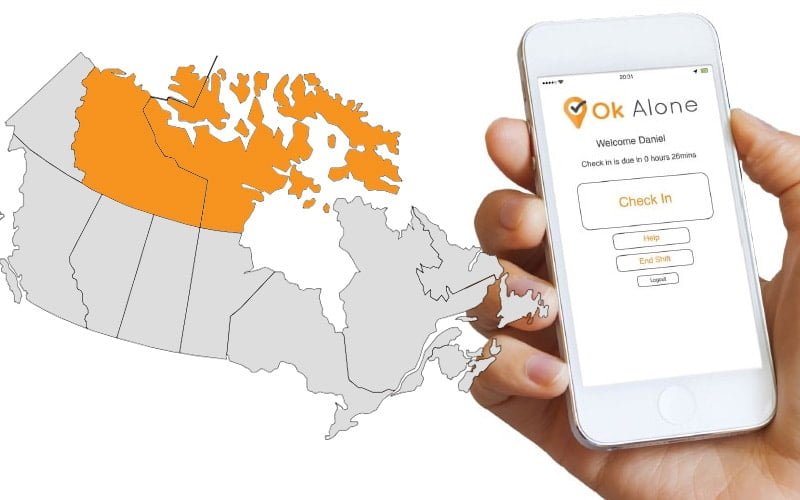As Canada is divided into federal, provincial and territorial jurisdictions here is the legislation pertaining to lone workers for The Northwest Territories and Nunavut.
Summary of Northwest Territories and Nunavut Lone Worker Legislation

In September 2016 the NORTHWEST TERRITORIES & NUNAVUT CODES OF PRACTICE was produced by the local governments in accordance with the Northwest Territories Safety Act, Occupational Health and Safety Regulations; and Nunavut Safety Act and Occupational Health and Safety Regulations.
They created the Working Alone code of practice which provides guidance to employers and workers to ensure the health and safety of employees who work alone. The Code provides a definition and description of working alone, outlines the legislation, and discusses hazard assessment and the development of safe work procedures.
They also produced the Working alone check-in procedure document which allows employers to assess whether or not their employee is working alone and requires additional support.
In a 2021 update to the Northwest Territories Occupational Health and Safety Regulations 2015 and the Nunavet Official Consolidation Of Occupational Health and Safety Regulations 2016 the definition of “isolated work site” was redefined as meaning;
(a) a work site that is more than one hour travel time from a hospital or medical facility under normal travel conditions using available means of surface transportation, or
(b) a work site for which transportation by aircraft is the normal or only method of transportation; (lieu de travail isolé). R-003-2021,s.2(b)
The areas of legislation that relate to employer’s responsibilities in both the Safety Acts and Health and Safety Regulations are below:
Northwest Territories Safety Act 1988 and Nunavut Consolidation of Safety Act 2016
HEALTH AND SAFETY
Duty of employer
4. (1) Every employer shall
(a) maintain his or her establishment in such a manner that the health and safety of persons in the establishment are not likely to be endangered;
(b) take all reasonable precautions and adopt and carry out all reasonable techniques and procedures to ensure the health and safety of every person in his or her establishment; and
(c) provide the first aid service requirements set out in the regulations pertaining to his or her class of establishment.
Coordination of employees
(2) If two or more employers have charge of an establishment, the principal contractor or, if there is no principal contractor, the owner of the establishment, shall coordinate the activities of the employers in the establishment to ensure compliance with subsection 4(1).
S.Nu. 2003,c.25,s.4. SNWT 2003,c.25,s.3.
Duty of worker
5. Every worker employed on or in connection with an establishment shall, in the course of his or her employment,
(a) take all reasonable precautions to ensure his or her own safety and the safety of other persons in the establishment; and
(b) as the circumstances require, use devices and articles of clothing or equipment that are intended for his or her protection and provided to the worker by his or her employer, or required pursuant to the regulations to be used or worn by the worker.

Northwest Territories Occupational Health and Safety Regulations 2015 (latest update 2024) and
Nunavet Official Consolidation Of Occupational Health and Safety Regulations 2016 (latest update 2021)
PART 1 PRELIMINARY MATTERS
Working Alone or at Isolated Work Site
33. (1) In this section, “work alone” means to work at a work site as the only worker at that work site, in circumstances where assistance from another person who is a first aid attendant is not readily available in the event of injury or emergency. (travailler seul)
(2) If a worker is required or permitted to work alone or at an isolated work site, an employer, in consultation with the Committee or representative or, if no Committee or representative is available, the worker and other workers, shall identify the hazards arising from the conditions and circumstances of that work.
(3) An employer shall take reasonable measures to eliminate or reduce the risks posed by the hazards identified under subsection (2), including the establishment of an effective communication system that consists of
(a) radio communication;
(b) phone or cellular phone communication; or
(c) any other means that provides effective communication considering the risks involved.
R-012-2020,s.7 R-003-2021,s.7.

As an expert in lone worker content management, I possess an extensive knowledge base and experience in the area of lone working and safety monitoring. My expertise in this field encompasses a wide range of areas, including risk assessment, training, communication, and technology. I have a deep understanding of the unique risks associated with lone workers and have researched and written many projects and articles to educate people in how to mitigate these risks.
Throughout my time with Ok Alone, I have kept up to date with technological developments, legislative changes and regulations that have been introduced to help organizations ensure the safety of their lone workers.

